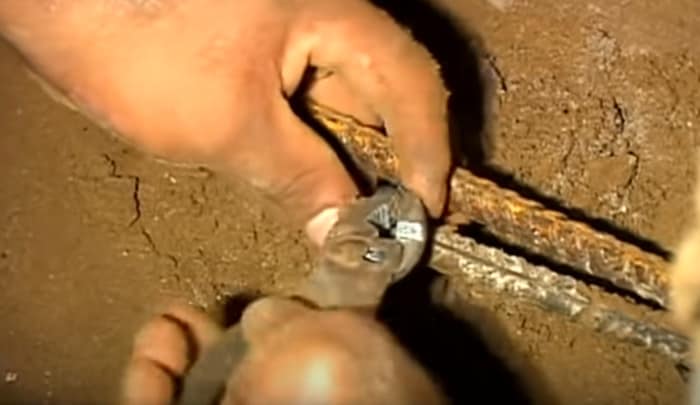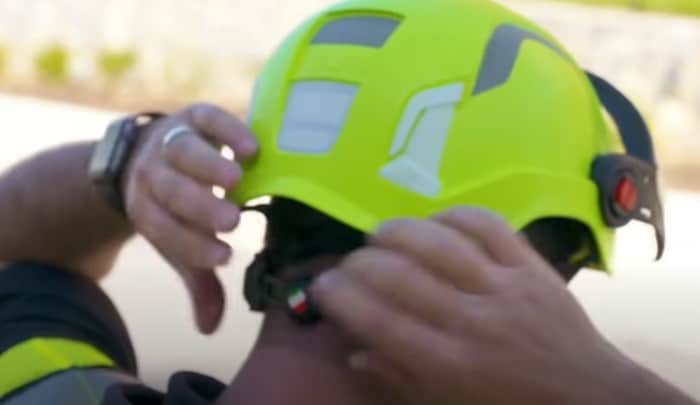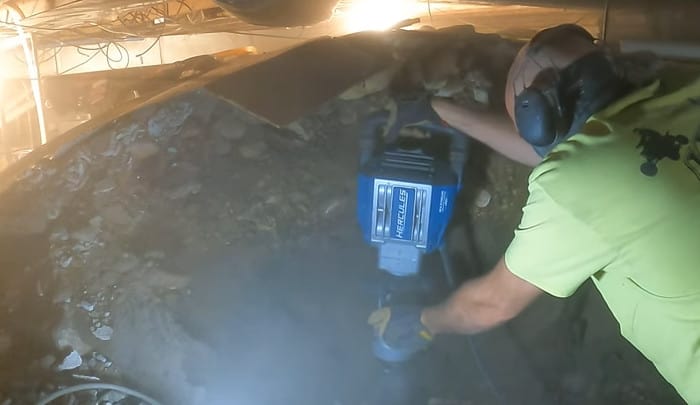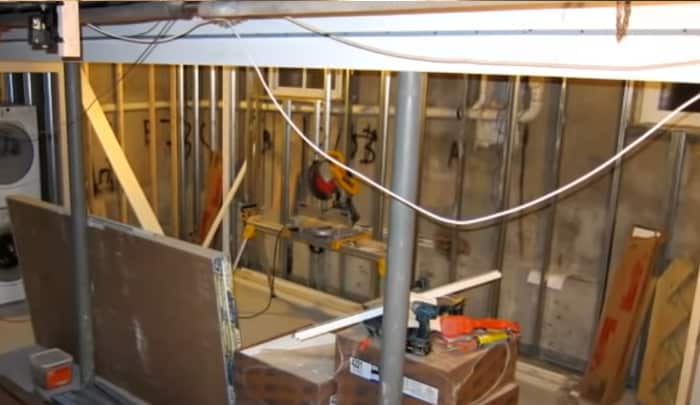If you’re wondering how to make your basement deeper without making a mess, demolishing, or disturbing the foundation of your home, you’ve come to the right place. Believe it or not, digging under your house isn’t as hard as you might think. With careful consideration and the right tools, you can properly and safely excavate that space under your home. In this guide, we will provide an easy-to-follow, step-by-step tutorial on how to dig under a house that’ll get the job done properly and safely. So, who’s ready to get digging? Let’s get started!
Before starting any type of excavation, you should contact the local planning and zoning department to ensure compliance with all regulations in your area. You should also have an experienced engineer or contractor review plans to make sure that the soil and foundations are suited for such a project.
“Careful evaluation of soil type and its load-bearing capacity is absolutely critical before digging under a house. A wrong move could imperil the structure. Don’t risk it. Consult a geo-technical engineer for a robust assessment. Work with professionals, ensure your safety, and protect your investment.”
Gilmore Taggart, Geo-Technical Engineer
Necessary Tools & Materials for Digging
Necessary Tools and Materials for Digging
Undertaking any kind of excavation requires a variety of specialized tools and materials. Before attempting to begin the digging process, it is imperative that you gather up all the necessary tools and materials beforehand in order to maximize efficiency and reduce potential risk while the digging is in progress.
Essential tools include a pickaxe, shovels, and wheelbarrow, since these will be needed to break up dirt and move it around. The pickaxe can be used primarily for hacking through bigger chunks of soil or rock. Besides shovels, you’ll also want to make sure you have other useful materials on hand such as plastic tarps and buckets. Tarps are great because they can help to catch falling dirt or debris when it’s time to start digging. Buckets are necessary for collecting any unearthed rocks or statutes, particularly if the plan is to completely relocate them elsewhere when the task is complete. It’s also important not to forget about water! Having water readily available can help prevent accidents from occurring due to a slippery excavation site as well as can be used as a makeshift dust suppressor if things get a bit too dry.
When it comes down to equipment versus manual labor for completing a project like this one, there’s no definitive answer as it really depends on the extent of the job and personal preference. On the one hand, using machines such as an excavator or bulldozer can make your job much faster since motorized tools naturally speed up any process exponentially. On the flip side, heavier machinery might require more space than what may be available at your location so leaning towards manual labor instead could prove to be your best bet. Whichever route you decide on, just remember that having the right tools ready is half of the battle in getting the work done correctly and safely.
Safety Precautions must be taken into consideration before undertaking any kind of excavation, regardless of its size or purpose. In this section we will go over some important safety considerations that should be implemented before beginning your digging process under your house.

- According to the International Residential Code, the minimum depth for unfinished basements is 7 feet from top of footing to the finished ceiling.
- The average depth for a basement is approximately 8 feet.
- In colder climates, such as Minnesota and Wisconsin, foundations may need to be deeper than 8 feet in order to protect from frost heave which can cause damage to the foundation.
Essential Points
Digging requires a variety of specialized tools and materials including a pickaxe, shovels, wheelbarrow, plastic tarps, buckets and water. It is up to personal preference whether to use motorized machines or manual labor for completing the job. Safety precautions must be taken into consideration prior to undertaking any excavation and should include implementation of certain safety considerations before beginning the digging process.
Safety Precautions to Consider
Safety is of utmost importance when it comes to digging under a house. While many people think that this practice is dangerous and should be avoided, it can be done safely as long as safety tips are followed. This is especially true when considering crawl space encapsulation, which can improve your home’s energy efficiency and air quality.
When planning to dig under a house, the first precaution to consider is to make sure the house itself is secure. Make sure there are no loose boards, structural damage, exposed wires, or other hazardous conditions. Check for any signs of cracks in the foundation walls, which could indicate stress and indicate a potential collapse if you dig too close or improperly support the foundation.
The next important factor to take into account is properly securing any electrical lines that run underground. Contact an electrician beforehand to ensure all existing wiring is located, labeled and disconnected. Also, determine whether permits or inspections are required in order to complete your project safely.
You should also create a plan before beginning work – map out where you need to dig and what materials or equipment you need to complete the job. This will help ensure that nothing is overlooked during the excavation process and reduce any risk of injury or damage. As well, provide notice to neighbors and family members who may be concerned about your safe practice when undertaking this activity.
Invest in supplies such as protective clothing and safety goggles, protective gloves, hard hats, shovels, limb saws, rakes and sledgehammers for excavation purposes (if necessary). Make sure all tools are clean and properly assessed prior to using. Access ladders for deep excavations must also be secured firmly with stable footing placed at both ends of each ladder and at least one safety line attached as back-up in case of a fall.
It’s important to consider ventilation in any underground structure as air can become polluted quickly. Consider purchasing a fan or ventilator if necessary to help circulate air while working underground. In addition, never attempt to do any of this work alone; always have someone with you who can help provide aid if needed during an accident or medical emergency situation happens.
Finally, keep hydrated by drinking frequent small amounts of water throughout the duration of your project; especially in hot weather conditions when working outside.
Once these safety precautions are taken into account and considered while digging under a house, the project can move forward with much less worry of potential risks associated with the task itself – allowing you to focus on completing the job properly! The following section will provide more information regarding possible hazards encountered while doing this kind of work and how best to protect oneself from them.

Protection from Hazards
Before beginning the process of digging under a house, it’s important to consider possible hazards and take proper steps to protect yourself. The main hazard associated with digging under a house is the physical danger posed by being located in an area that may contain exposed live wires, underground plumbing, or weakened structural supports. Additionally, there is also potential health risk depending on conditions like flooding, toxic materials present, mold or bacteria growth due to standing water, and airborne dust particles stirred up during the excavation process.
To guard against these risks, it’s essential to first research thoroughly any utility lines that run beneath the area in question. In most cases you can call your local utility or governmental authority to get this information. Furthermore, installing protective equipment such as shields or shields around power lines is also beneficial in order to reduce shock risks. Fitting ear plugs and other protective gear like masks and glasses are also important to reduce risks from flying foreign objects while digging.
Finally, having someone monitoring the site and a sober supervisor present is beneficial to ensure no one tries to enter the area without permission. If any hazardous condition is identified on-site it’s imperative that specialists certified for safety analysis be consulted before proceeding with any excavation plans.
In conclusion, taking the necessary precautions before beginning any kind of excavation project can help keep everyone safe from potential dangers and mitigate risks of any structure or system damage occurring as result of digging under a house. Now that we have discussed protection from hazards let’s move on to instructions for digging under a house.
Instructions for Digging Under a House
Digging under a house is one of the most involved improvement projects to undertake. There are several tips you must know before beginning the job, especially if you plan to use heavy machinery for larger excavation projects. Understanding the process will save time, energy, and money in the long run.
One of the main things to consider when deciding how to dig under a house is its location. If you live in an area that experiences seasonal rains and flooding, you may need extra precautions such as waterproofing methods or sandbags. Additionally, consider the house’s distance from roads and utility lines. It’s important to avoid inaccurate excavations that could rip service lines up or cause damage to your property.
It is also important to work with professional contractors who have experience in this field. Professional contractors will be able to provide detailed instructions on safety measures as well as specialized equipment that should be used for this type of project. They will also be able to perform land survey tests or coordinate with municipalities if needed for specific permits and regulations.
Once the working space is cleared and all necessary permits are obtained, it’s now time for the actual digging process- starting with verification if the excavation plan corresponds with the building foundation plan. The depth and width of the digging area depend on what needs to be accessed beneath the house- sewer line, drainage pipe, or power line installation. When done correctly, a soil vacuum can be used to suck out dirt quickly instead of shoveling it manually- though manual labor may still prove necessary in some hard-to-reach areas. When finished digging, a layer of wet concrete should be applied within 24 hours of completion (elevations permitting) so as not to compromise structural soundness of adjoining materials such as floor joists and masonry walls.
It is always good practice strategy to keep family members (especially children) away from excavated areas until they are cleared safe for human contact and inspection has been completed by proper personnel.If possible, create barriers separating excavated area from living spaces in order to reduce dust particles release into surrounding atmosphere (inhalation).
Converting a crawl space into a basement greatly increases your home’s value in terms of improvements and utility accesses under certain circumstances, as long as safety recommendations are followed based on local situations and conditions at hand. When done correctly, however, installing sewer line, drainage pipes or power lines will add more beauty and convenience to any home whether it’s on flat ground or hillside locations like hillsides -provided all necessary codes are met throughout the process according with local municipality regulations for such applications.
Now that all necessary preparations have been made for digging under your house safely, let us discuss how best to install sewer, drainage, or power line in our next section.

Installing Sewer, Drainage, or Power Line
When excavating around a house, the most common reason is to install sewer, drainage, or power line infrastructure. Depending on the type of soil structure, depth and size of the project, as well as existing utilities that could interfere with digging, proper planning is needed. Each project should be carefully inspected for accuracy and safety measures.
One option for installing these utilities is by hand-digging a trench manually or using a backhoe. Hand digging requires more labor and typically takes more time to complete. In comparison, backhoes require an operator to use several pieces of equipment including a mini-excavator, bucket blades, and an auger attachment. It is also important to remember that when excavating near or under a house it may be necessary to shimmy or “step” over structural posts and components like cables to avoid damage. Backhoes do provide more flexibility in maneuvering around those obstacles however potential risks exist if any underground obstructions are missed during initial assessments.
On the other hand, directional drilling machines can be used when digging is not feasible due to limited access or depth considerations. These machines have become popular due to their ability to bore through difficult terrains like hard soils and rock quickly and efficiently. After drilling is complete, utility lines can be inserted directly into the new openings before being sealed shut by grout injection. The risk associated with this type of installation method is primarily related to the potential missed detection of existing utilities that are hidden or close together underground which could lead to damaging leaks or extensive repair costs.
At the end of the day, whichever method best fits the project requirements should be taken into consideration; however proper inspections and planning need to be conducted beforehand for any successful installation process.
Now that sewer, drainage and power lines have been installed we need to proceed with destruction of root systems & foundation work which will be discussed in the following section.
Destruction of Root System & Foundation
Destroying the root system and foundation of the house is a necessary step in the process of digging under it. It can be a challenging task, so it’s important to understand the different methods available, as well as potential hazards and safety tips.
One option for destroying roots is power tools such as an earth auger or electric drill. Earth augers are designed to cut and remove roots quickly and efficiently while electric drills can be used to bore holes into tree trunks. These tools can damage delicate shallow root systems, but they are generally quite effective at breaking deeper root systems. Additionally, there is no risk of harming houses with these tools as they are designed to work around structures.
Another option is using chemicals, such as herbicides or glyphosate-based sprays, which dissolve certain types of roots without impacting the structure of your house. However, this method can be expensive and results may take longer to see compared to other methods. Additionally, applying chemicals incorrectly could cause harm to vegetation near the house or even potentially leach toxins into surrounding groundwater supplies; this must therefore be done with great care.
Yet another way of weakening roots is by mechanically removing them from the soil and cutting them away from the base of the tree or shrub. This requires a more manual approach and more time onsite, but will ensure you don’t break any nearby stonework or damage other surroundings in the process of uprooting.
It is important to weigh both risks and benefits when deciding on the best method for destroying your root system and foundation before you begin digging under your house. Consider factors such as maintaining proper humidity for hardwood floors if you plan to install them in your new basement space. Always be sure to follow all safety regulations and guidelines in order to prevent any accidents resulting in property or personal injury during this process.
With these considerations in mind, we now move onto our final section – concluding thoughts and overall tips for digging under a house.
Conclusion and Overall Tips for Digging Under a House
Before attempting to dig under your house, it is important to understand the implications of this task, as there may be aspects such as local building regulations and permits that need to be accounted for before beginning. It is also important to consider the safety implications of undertaking such a project, whether doing it yourself or hiring professionals. With the right precautions, however, digging under your house can be an effective way to increase storage space or even install piping or wiring.
Overall, the following tips should help guide you if you choose to go ahead with the project:
1. Make sure that you have accurately determined the depth at which you need to dig. This will determine how much labor needs to be put into the project.
2. Obtain any necessary building permits or clearances before construction begins.
3. Plan in advance as much of your route and equipment as possible so you don’t run into problems when working beneath your house.
4. Use appropriate tools and techniques for excavation and maintenance of the space in order to avoid hazardous situations or damage being caused either during or after completion of the job.
5. Hire a professional contractor if needed – many of these projects do not require a lot of specialised skill but depending on the complexity it may be worth consulting a professional who has experience completing similar tasks safely and efficiently .
In addition, although digging under your house can be done without causing structural damage, there is always a chance that something could go wrong while working underground and cause damage above ground. It is crucial to balance out this risk with considerations of cost against impact; if the risk outweighs the reward then it may not make sense financially nor structurally to proceed with such a project in this manner rather than using other methods such as using a framing system around an existing foundation slab.

Responses to Common Questions with Detailed Explanations
Are there any permits or regulations I should be aware of before digging under a house?
Yes, you should always be aware of and follow the permits and regulations for digging under a house. A permit is typically required to legally start any major dig or construction project near a property line. Additionally, certain safety regulations may apply in certain areas, such as minimum depths of dug trenches and additional resources needed to complete your project. It is also important to check local building codes and ordinances to make sure any changes you plan to make comply with all laws in your area. Taking all of these steps before starting your project will ensure that your project is legal and safe.
What tools are required for digging under a house?
It is important to have the right tools for digging under a house. The most essential items you will need are a spade, pickaxe, shovel, wheelbarrow, and protective clothing. A spade is necessary to dig large shallow holes. A pickaxe is best for breaking up rocks or other tough soil surface. A shovel is needed for clearing away debris and loose soil. Finally, a sturdy wheelbarrow can help move large amounts of dirt in one trip. In addition to these basic tools, it’s also important to wear protective clothing such as gloves, goggles, ear plugs, and steel-toed boots with appropriate grip on the soles.
What safety precautions should be taken when digging under a house?
Safety should always be the top priority when undertaking any type of excavation project, especially when digging under a house. A few safety precautions that should be taken include:
– Wear protective eyewear, gloves, and boots. It is also a good idea to wear a hard hat and reflective vest to make sure you are visible in the event that someone else is in the area.
– Invest in better quality tools. Using inferior tools can lead to longer working hours and enable accidents to occur.
– Mark off the work area with warning tape or barriers. This will prevent anyone from straying into the excavation area and thus reduce the risk of injury.
– Make sure to check for gas, water, or electric lines before starting the job. Contact your local utilities office for clarity on this matter and ensure all lines are properly marked before beginning.
– Put up hazard signs near entrances and exits as well as other areas around the excavation site in case of emergencies.
– Use appropriate ventilation systems when necessary to prevent carbon monoxide poisoning and other hazardous fumes trapped in enclosed areas.
By following these simple yet important safety precautions, you can safely dig under a house and avoid potential harm to yourself and others around you.





In my years of experience, I found it critical to prioritise safe excavation methods that would reduce the risk of destabilising the house’s structure. First, assessing the soil type and its bearing capacity is essential. Also, never underestimate the power of bracing systems, they could save your home from an unwanted catastrophe.
As an engineer, I resonate with Percival’s comment on safe excavation methods. It reminds me of a project I worked on where we had to dig under an ancient Victorian home which was a matter of precision, patience, and, most importantly, the right equipment and bracing system.
Exactly, Vanderbilt! Got plenty of stories about tunnels under houses… just like the one where we accidentally discovered a forgotten 17th Century well, crazy times!
I’d like to second Maxine’s comment about unexpected discoveries when digging under houses. In my career as a civil engineer, I’ve come across everything from vintage tools to buried treasure chests. Proper excavation is not just about avoiding making a mess or damaging foundations, but it’s also considering what forgotten pieces of history you might unearth. Always remember to contact your local Heritage Council or similar body if you come across anything historically significant.
I once worked on a late Victorian era house where we discovered a labyrinth of century-old pipes during our excavation process. It was both fun and challenging to navigate that situation without disturbing too much of the original architecture.
It’s fascinating how old structures throw up such unexpected challenges, Zelda. I recall working on a similar project where a seemingly easy excavation turned into a complex task due to an intricate network of old stormwater drains dating back to the early 1900s.
I can surely echo that sentiment, Xander – never underestimate what you might uncover during a dig. In my experience, it’s the unexpected obstacles that test not only your technical skills but also your problem-solving prowess.
Absolutely right, Roscoe; unexpected obstacles can pop out even for seasoned experts like us. I remember this one time I found a massive fieldstone during an extraction – it took hours of careful maneuvering before we could proceed with the project. Problem-solving on-the-fly becomes second nature after enough runs in with these subterranean surprises. It’s always crucial to consider all potential scenarios you might face when starting a dig, and preparing the right tools can help make these problems manageable.
Just last month I used this method to dig under my old farmhouse to install some plumbing, the key was to take it slow and steady!